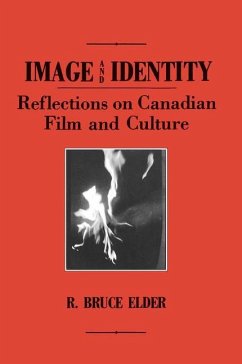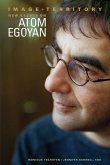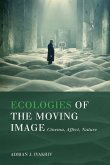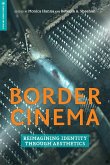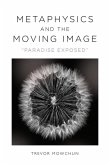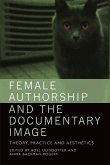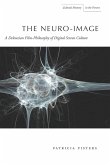- Broschiertes Buch
- Merkliste
- Auf die Merkliste
- Bewerten Bewerten
- Teilen
- Produkt teilen
- Produkterinnerung
- Produkterinnerung
Examines the unique qualities of Canadian cinema, situating it within the broader spectrum of Canadian culture as a whole. Bruce Elder explores the essential features of Canadian thought and the distinctive Canadian philosophical traditions that developed in response to our particular historical and geographical circumstances.
Andere Kunden interessierten sich auch für
![Image and Territory Image and Territory]() Image and Territory45,99 €
Image and Territory45,99 €![Ecologies of the Moving Image Ecologies of the Moving Image]() Adrian J IvakhivEcologies of the Moving Image57,99 €
Adrian J IvakhivEcologies of the Moving Image57,99 €![Border Cinema: Reimagining Identity Through Aesthetics Border Cinema: Reimagining Identity Through Aesthetics]() Border Cinema: Reimagining Identity Through Aesthetics43,99 €
Border Cinema: Reimagining Identity Through Aesthetics43,99 €![Metaphysics and the Moving Image Metaphysics and the Moving Image]() Trevor MowchunMetaphysics and the Moving Image35,99 €
Trevor MowchunMetaphysics and the Moving Image35,99 €![Female Authorship and the Documentary Image Female Authorship and the Documentary Image]() Female Authorship and the Documentary Image35,99 €
Female Authorship and the Documentary Image35,99 €![The Neuro-Image The Neuro-Image]() Patricia PistersThe Neuro-Image36,99 €
Patricia PistersThe Neuro-Image36,99 €![Nation and Identity in the New German Cinema Nation and Identity in the New German Cinema]() Inga ScharfNation and Identity in the New German Cinema69,99 €
Inga ScharfNation and Identity in the New German Cinema69,99 €-
-
-
Examines the unique qualities of Canadian cinema, situating it within the broader spectrum of Canadian culture as a whole. Bruce Elder explores the essential features of Canadian thought and the distinctive Canadian philosophical traditions that developed in response to our particular historical and geographical circumstances.
Hinweis: Dieser Artikel kann nur an eine deutsche Lieferadresse ausgeliefert werden.
Hinweis: Dieser Artikel kann nur an eine deutsche Lieferadresse ausgeliefert werden.
Produktdetails
- Produktdetails
- Verlag: Wilfrid Laurier University Press
- Seitenzahl: 483
- Erscheinungstermin: 1. Januar 2006
- Englisch
- Abmessung: 226mm x 150mm x 25mm
- Gewicht: 676g
- ISBN-13: 9781554584697
- ISBN-10: 1554584698
- Artikelnr.: 35338104
- Herstellerkennzeichnung
- Libri GmbH
- Europaallee 1
- 36244 Bad Hersfeld
- gpsr@libri.de
- Verlag: Wilfrid Laurier University Press
- Seitenzahl: 483
- Erscheinungstermin: 1. Januar 2006
- Englisch
- Abmessung: 226mm x 150mm x 25mm
- Gewicht: 676g
- ISBN-13: 9781554584697
- ISBN-10: 1554584698
- Artikelnr.: 35338104
- Herstellerkennzeichnung
- Libri GmbH
- Europaallee 1
- 36244 Bad Hersfeld
- gpsr@libri.de
R. Bruce Elder is an award-winning filmmaker and teaches media at Ryerson University. His book Harmony & Dissent (WLU Press, 2008) received the prestigious Robert Motherwell Book Prize and was named a Choice Outstanding Academic Book. Rudolf Kuenzli described DADA, Surrealism, and the Cinematic Effect (WLU Press, 2013) as "that rare book that casts the early twentieth-century avant-garde in a very new light."
Table of Contents for
Image and Identity: Reflections on Canadian Film and Culture by R. Bruce
Elder
Foreword
Preface
Acknowledgements
Introduction
PART ONE
Introduction: In Reality, Who Are We?
CHAPTER 1 A House Divided
Three Primal Experiences
The Garrison Mentality
A Tragic Vision
CHAPTER 2 Two Schools of Thought
American-Style Liberalism
The Epistemology of Empiricism
Common Sense
Dualism and Representation
Common Sense and Calvinism
Absolute Idealism
The Absolute
The Nation-State
Absolute Idealism in Canada
CHAPTER 3 An Aesthetic of Reconciliation
PART TWO
Introduction
CHAPTER 4 The Documentary Film in Canada
Absolute Idealism in Canada
The Legacy of John Grierson
The Influence of Grierson
The Candid-Eye Movement
The Crisis Structure of American Cinéma-vérité
The Observational Structure of Candid-Eye Films
Two Journalistic Influences
The Empirical Character of the Candid-Eye Films
Not a Love Story
CHAPTER 5 Narrative Transmission in American Direct Cinema Films and
Canadian Candid-Eye Films
Narrative Modes of Transmission
Agents of Narrative Transmission
Cinéma-vérité as the Mimesis of a Mimesis
Imagery as Illustration: the "Literary" Quality of NFB Documentaries
The Days Before Christmas
Candid-Eye Films and Common-Sense Philosophy
Blood and Fire
CHAPTER 6 The Reality Principle: "Goin' Down the Road"
What Do Pete and Joey Want?
Ideas and Actions
The Repressions of the Reality Principle
The Non-Empirical Cinema of Quebec
The Problems of the Empirical Style
The Limitations of the Reality Principle
CHAPTER 7 Modes of Representation in Cinema
The Cinema of Presentation, the Cinema of Illustration, the Cinema of
Construction
A Paradigmatic Contrast
A Contrast of Epistemologies
The Search-and-Discovery Structure in the Cinema of Presentation
Some Historical Background
Classical and Post-classical Art
The Telos of Total Realism
PART THREE
Introduction
CHAPTER 8 Michael Snow's "Wavelength"
The Cinema of Presentation, the Cinema of Illustration, the Cinema of
Construction
A Minimal Film
A Phenomenological Film
A Durational Film
A Dramatic Film
An Experiential Film
Drama, Space and Time
Drama, Light and Sound
Dramatic Form as a Narrowing of Possibility
Drama and Temporal Continuity
Remarks on the Zoom
A Film of Purity
The Achievement of the Film
CHAPTER 9 From Painting into Cinema: A Study of Jack Chambers' "Circle"
Two Tendencies in Twentieth-Century Art
Chambers' Painting as a Prelude to Filmmaking
Perceptual Realism and Romanticism
Perceptual Realism and Photography
Circle
Circle: Section One
Circle: Section Two
Circle: Section Three
CHAPTER 10 All Things in Their Time: On Michael Snow's
The Background of the Film
Snow's Multifaceted Work
From Modernism to Postmodernism
Experiencing Snow's Films
>
Snow's Postmodernist Associates 1: David Rimmer
Snow's Postmodernist Associates 11: Joyce Wieland
CHAPTER 11 The Photographic Image in Canadian Avant-Garde Film
The Background of the Film
Postmodernism vs Modernism
The Paradoxes of Photographic Representation
Postmodernism and Otherness
Camera Movement and Highlighting Absence: the Case of Chris Gallagher
The Frame and Absent Space: the Cases of Epp and Snow
Representation and Presentation: the Case of David Rimmer
The Single-Shot Film
The Relation of Text and Image: Postmodernist Strategies
The Duality of Photography
CHAPTER 12 Michael Snow Presents "Presents"
Ut Pictura Poesis
Modernism and the Metaphysics of Presence
Presents and the Challenge to the Metaphysics of Presence
Presents in the Light of Language Theory
The Architecture of Presents
So Is This in the Light of Language Theory
Presence, Time, Language and Knowledge
Reprise: Ut Pictura Poesis
CHAPTER 13 Idealism, Photography and the Canadian Avant-Garde Film
Graphic Cinema
Peter Kubelka's Theory and Practice
Eisenstein's Theory
Germaine Dulac
Sydney Peterson's Views
Against the Petersonian View: Maya Deren
Romanticism, Hegel, and the Underpinnings of a Canadian Attitude Towards
Photography
Self and Other: The Undergirding of Romanticism
Chambers' Art: The Amalgam of Subjectivity and Objectivity
The Rhythms of Life and Death: Chambers' Films
Nature, Idealism and the Photograph in Canadian Thought
CHAPTER 14 Forms of Cinema: Models of Self
Image and Identity
Hart of London
La région centrale
The Transcendental Self, La région centrale, and Idealist Thought
Notes
Appendix: Filmographies
Bibliography
Index
Image and Identity: Reflections on Canadian Film and Culture by R. Bruce
Elder
Foreword
Preface
Acknowledgements
Introduction
PART ONE
Introduction: In Reality, Who Are We?
CHAPTER 1 A House Divided
Three Primal Experiences
The Garrison Mentality
A Tragic Vision
CHAPTER 2 Two Schools of Thought
American-Style Liberalism
The Epistemology of Empiricism
Common Sense
Dualism and Representation
Common Sense and Calvinism
Absolute Idealism
The Absolute
The Nation-State
Absolute Idealism in Canada
CHAPTER 3 An Aesthetic of Reconciliation
PART TWO
Introduction
CHAPTER 4 The Documentary Film in Canada
Absolute Idealism in Canada
The Legacy of John Grierson
The Influence of Grierson
The Candid-Eye Movement
The Crisis Structure of American Cinéma-vérité
The Observational Structure of Candid-Eye Films
Two Journalistic Influences
The Empirical Character of the Candid-Eye Films
Not a Love Story
CHAPTER 5 Narrative Transmission in American Direct Cinema Films and
Canadian Candid-Eye Films
Narrative Modes of Transmission
Agents of Narrative Transmission
Cinéma-vérité as the Mimesis of a Mimesis
Imagery as Illustration: the "Literary" Quality of NFB Documentaries
The Days Before Christmas
Candid-Eye Films and Common-Sense Philosophy
Blood and Fire
CHAPTER 6 The Reality Principle: "Goin' Down the Road"
What Do Pete and Joey Want?
Ideas and Actions
The Repressions of the Reality Principle
The Non-Empirical Cinema of Quebec
The Problems of the Empirical Style
The Limitations of the Reality Principle
CHAPTER 7 Modes of Representation in Cinema
The Cinema of Presentation, the Cinema of Illustration, the Cinema of
Construction
A Paradigmatic Contrast
A Contrast of Epistemologies
The Search-and-Discovery Structure in the Cinema of Presentation
Some Historical Background
Classical and Post-classical Art
The Telos of Total Realism
PART THREE
Introduction
CHAPTER 8 Michael Snow's "Wavelength"
The Cinema of Presentation, the Cinema of Illustration, the Cinema of
Construction
A Minimal Film
A Phenomenological Film
A Durational Film
A Dramatic Film
An Experiential Film
Drama, Space and Time
Drama, Light and Sound
Dramatic Form as a Narrowing of Possibility
Drama and Temporal Continuity
Remarks on the Zoom
A Film of Purity
The Achievement of the Film
CHAPTER 9 From Painting into Cinema: A Study of Jack Chambers' "Circle"
Two Tendencies in Twentieth-Century Art
Chambers' Painting as a Prelude to Filmmaking
Perceptual Realism and Romanticism
Perceptual Realism and Photography
Circle
Circle: Section One
Circle: Section Two
Circle: Section Three
CHAPTER 10 All Things in Their Time: On Michael Snow's
The Background of the Film
Snow's Multifaceted Work
From Modernism to Postmodernism
Experiencing Snow's Films
>
Snow's Postmodernist Associates 1: David Rimmer
Snow's Postmodernist Associates 11: Joyce Wieland
CHAPTER 11 The Photographic Image in Canadian Avant-Garde Film
The Background of the Film
Postmodernism vs Modernism
The Paradoxes of Photographic Representation
Postmodernism and Otherness
Camera Movement and Highlighting Absence: the Case of Chris Gallagher
The Frame and Absent Space: the Cases of Epp and Snow
Representation and Presentation: the Case of David Rimmer
The Single-Shot Film
The Relation of Text and Image: Postmodernist Strategies
The Duality of Photography
CHAPTER 12 Michael Snow Presents "Presents"
Ut Pictura Poesis
Modernism and the Metaphysics of Presence
Presents and the Challenge to the Metaphysics of Presence
Presents in the Light of Language Theory
The Architecture of Presents
So Is This in the Light of Language Theory
Presence, Time, Language and Knowledge
Reprise: Ut Pictura Poesis
CHAPTER 13 Idealism, Photography and the Canadian Avant-Garde Film
Graphic Cinema
Peter Kubelka's Theory and Practice
Eisenstein's Theory
Germaine Dulac
Sydney Peterson's Views
Against the Petersonian View: Maya Deren
Romanticism, Hegel, and the Underpinnings of a Canadian Attitude Towards
Photography
Self and Other: The Undergirding of Romanticism
Chambers' Art: The Amalgam of Subjectivity and Objectivity
The Rhythms of Life and Death: Chambers' Films
Nature, Idealism and the Photograph in Canadian Thought
CHAPTER 14 Forms of Cinema: Models of Self
Image and Identity
Hart of London
La région centrale
The Transcendental Self, La région centrale, and Idealist Thought
Notes
Appendix: Filmographies
Bibliography
Index
Table of Contents for
Image and Identity: Reflections on Canadian Film and Culture by R. Bruce
Elder
Foreword
Preface
Acknowledgements
Introduction
PART ONE
Introduction: In Reality, Who Are We?
CHAPTER 1 A House Divided
Three Primal Experiences
The Garrison Mentality
A Tragic Vision
CHAPTER 2 Two Schools of Thought
American-Style Liberalism
The Epistemology of Empiricism
Common Sense
Dualism and Representation
Common Sense and Calvinism
Absolute Idealism
The Absolute
The Nation-State
Absolute Idealism in Canada
CHAPTER 3 An Aesthetic of Reconciliation
PART TWO
Introduction
CHAPTER 4 The Documentary Film in Canada
Absolute Idealism in Canada
The Legacy of John Grierson
The Influence of Grierson
The Candid-Eye Movement
The Crisis Structure of American Cinéma-vérité
The Observational Structure of Candid-Eye Films
Two Journalistic Influences
The Empirical Character of the Candid-Eye Films
Not a Love Story
CHAPTER 5 Narrative Transmission in American Direct Cinema Films and
Canadian Candid-Eye Films
Narrative Modes of Transmission
Agents of Narrative Transmission
Cinéma-vérité as the Mimesis of a Mimesis
Imagery as Illustration: the "Literary" Quality of NFB Documentaries
The Days Before Christmas
Candid-Eye Films and Common-Sense Philosophy
Blood and Fire
CHAPTER 6 The Reality Principle: "Goin' Down the Road"
What Do Pete and Joey Want?
Ideas and Actions
The Repressions of the Reality Principle
The Non-Empirical Cinema of Quebec
The Problems of the Empirical Style
The Limitations of the Reality Principle
CHAPTER 7 Modes of Representation in Cinema
The Cinema of Presentation, the Cinema of Illustration, the Cinema of
Construction
A Paradigmatic Contrast
A Contrast of Epistemologies
The Search-and-Discovery Structure in the Cinema of Presentation
Some Historical Background
Classical and Post-classical Art
The Telos of Total Realism
PART THREE
Introduction
CHAPTER 8 Michael Snow's "Wavelength"
The Cinema of Presentation, the Cinema of Illustration, the Cinema of
Construction
A Minimal Film
A Phenomenological Film
A Durational Film
A Dramatic Film
An Experiential Film
Drama, Space and Time
Drama, Light and Sound
Dramatic Form as a Narrowing of Possibility
Drama and Temporal Continuity
Remarks on the Zoom
A Film of Purity
The Achievement of the Film
CHAPTER 9 From Painting into Cinema: A Study of Jack Chambers' "Circle"
Two Tendencies in Twentieth-Century Art
Chambers' Painting as a Prelude to Filmmaking
Perceptual Realism and Romanticism
Perceptual Realism and Photography
Circle
Circle: Section One
Circle: Section Two
Circle: Section Three
CHAPTER 10 All Things in Their Time: On Michael Snow's
The Background of the Film
Snow's Multifaceted Work
From Modernism to Postmodernism
Experiencing Snow's Films
>
Snow's Postmodernist Associates 1: David Rimmer
Snow's Postmodernist Associates 11: Joyce Wieland
CHAPTER 11 The Photographic Image in Canadian Avant-Garde Film
The Background of the Film
Postmodernism vs Modernism
The Paradoxes of Photographic Representation
Postmodernism and Otherness
Camera Movement and Highlighting Absence: the Case of Chris Gallagher
The Frame and Absent Space: the Cases of Epp and Snow
Representation and Presentation: the Case of David Rimmer
The Single-Shot Film
The Relation of Text and Image: Postmodernist Strategies
The Duality of Photography
CHAPTER 12 Michael Snow Presents "Presents"
Ut Pictura Poesis
Modernism and the Metaphysics of Presence
Presents and the Challenge to the Metaphysics of Presence
Presents in the Light of Language Theory
The Architecture of Presents
So Is This in the Light of Language Theory
Presence, Time, Language and Knowledge
Reprise: Ut Pictura Poesis
CHAPTER 13 Idealism, Photography and the Canadian Avant-Garde Film
Graphic Cinema
Peter Kubelka's Theory and Practice
Eisenstein's Theory
Germaine Dulac
Sydney Peterson's Views
Against the Petersonian View: Maya Deren
Romanticism, Hegel, and the Underpinnings of a Canadian Attitude Towards
Photography
Self and Other: The Undergirding of Romanticism
Chambers' Art: The Amalgam of Subjectivity and Objectivity
The Rhythms of Life and Death: Chambers' Films
Nature, Idealism and the Photograph in Canadian Thought
CHAPTER 14 Forms of Cinema: Models of Self
Image and Identity
Hart of London
La région centrale
The Transcendental Self, La région centrale, and Idealist Thought
Notes
Appendix: Filmographies
Bibliography
Index
Image and Identity: Reflections on Canadian Film and Culture by R. Bruce
Elder
Foreword
Preface
Acknowledgements
Introduction
PART ONE
Introduction: In Reality, Who Are We?
CHAPTER 1 A House Divided
Three Primal Experiences
The Garrison Mentality
A Tragic Vision
CHAPTER 2 Two Schools of Thought
American-Style Liberalism
The Epistemology of Empiricism
Common Sense
Dualism and Representation
Common Sense and Calvinism
Absolute Idealism
The Absolute
The Nation-State
Absolute Idealism in Canada
CHAPTER 3 An Aesthetic of Reconciliation
PART TWO
Introduction
CHAPTER 4 The Documentary Film in Canada
Absolute Idealism in Canada
The Legacy of John Grierson
The Influence of Grierson
The Candid-Eye Movement
The Crisis Structure of American Cinéma-vérité
The Observational Structure of Candid-Eye Films
Two Journalistic Influences
The Empirical Character of the Candid-Eye Films
Not a Love Story
CHAPTER 5 Narrative Transmission in American Direct Cinema Films and
Canadian Candid-Eye Films
Narrative Modes of Transmission
Agents of Narrative Transmission
Cinéma-vérité as the Mimesis of a Mimesis
Imagery as Illustration: the "Literary" Quality of NFB Documentaries
The Days Before Christmas
Candid-Eye Films and Common-Sense Philosophy
Blood and Fire
CHAPTER 6 The Reality Principle: "Goin' Down the Road"
What Do Pete and Joey Want?
Ideas and Actions
The Repressions of the Reality Principle
The Non-Empirical Cinema of Quebec
The Problems of the Empirical Style
The Limitations of the Reality Principle
CHAPTER 7 Modes of Representation in Cinema
The Cinema of Presentation, the Cinema of Illustration, the Cinema of
Construction
A Paradigmatic Contrast
A Contrast of Epistemologies
The Search-and-Discovery Structure in the Cinema of Presentation
Some Historical Background
Classical and Post-classical Art
The Telos of Total Realism
PART THREE
Introduction
CHAPTER 8 Michael Snow's "Wavelength"
The Cinema of Presentation, the Cinema of Illustration, the Cinema of
Construction
A Minimal Film
A Phenomenological Film
A Durational Film
A Dramatic Film
An Experiential Film
Drama, Space and Time
Drama, Light and Sound
Dramatic Form as a Narrowing of Possibility
Drama and Temporal Continuity
Remarks on the Zoom
A Film of Purity
The Achievement of the Film
CHAPTER 9 From Painting into Cinema: A Study of Jack Chambers' "Circle"
Two Tendencies in Twentieth-Century Art
Chambers' Painting as a Prelude to Filmmaking
Perceptual Realism and Romanticism
Perceptual Realism and Photography
Circle
Circle: Section One
Circle: Section Two
Circle: Section Three
CHAPTER 10 All Things in Their Time: On Michael Snow's
The Background of the Film
Snow's Multifaceted Work
From Modernism to Postmodernism
Experiencing Snow's Films
>
Snow's Postmodernist Associates 1: David Rimmer
Snow's Postmodernist Associates 11: Joyce Wieland
CHAPTER 11 The Photographic Image in Canadian Avant-Garde Film
The Background of the Film
Postmodernism vs Modernism
The Paradoxes of Photographic Representation
Postmodernism and Otherness
Camera Movement and Highlighting Absence: the Case of Chris Gallagher
The Frame and Absent Space: the Cases of Epp and Snow
Representation and Presentation: the Case of David Rimmer
The Single-Shot Film
The Relation of Text and Image: Postmodernist Strategies
The Duality of Photography
CHAPTER 12 Michael Snow Presents "Presents"
Ut Pictura Poesis
Modernism and the Metaphysics of Presence
Presents and the Challenge to the Metaphysics of Presence
Presents in the Light of Language Theory
The Architecture of Presents
So Is This in the Light of Language Theory
Presence, Time, Language and Knowledge
Reprise: Ut Pictura Poesis
CHAPTER 13 Idealism, Photography and the Canadian Avant-Garde Film
Graphic Cinema
Peter Kubelka's Theory and Practice
Eisenstein's Theory
Germaine Dulac
Sydney Peterson's Views
Against the Petersonian View: Maya Deren
Romanticism, Hegel, and the Underpinnings of a Canadian Attitude Towards
Photography
Self and Other: The Undergirding of Romanticism
Chambers' Art: The Amalgam of Subjectivity and Objectivity
The Rhythms of Life and Death: Chambers' Films
Nature, Idealism and the Photograph in Canadian Thought
CHAPTER 14 Forms of Cinema: Models of Self
Image and Identity
Hart of London
La région centrale
The Transcendental Self, La région centrale, and Idealist Thought
Notes
Appendix: Filmographies
Bibliography
Index

